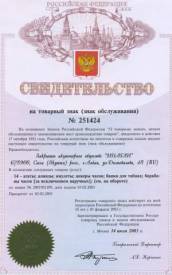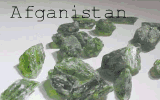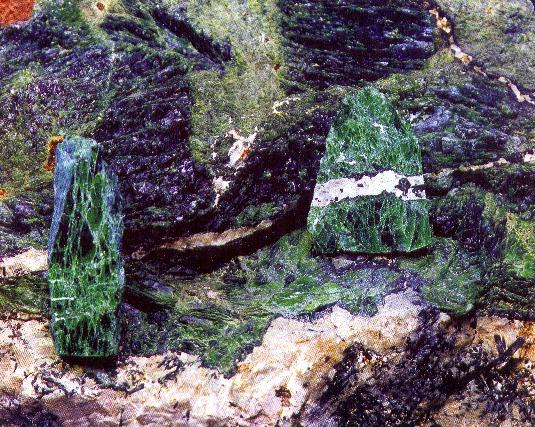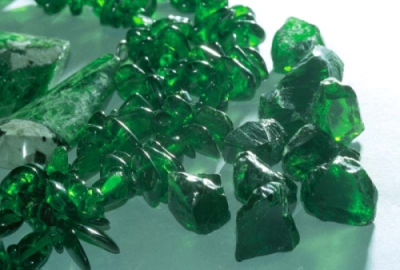 In the frost-bitten highlands of Yakutia, remote corner of Russian Siberia, and
under the most adverse climatic conditions we mine Sibirlite (chrome diopside),
a gem of magnificent saturated color, rival to costly tsavorite and emerald.
Situated on the ancient tectonic Aldan shield,
Inagli deposit of chrome diopside was discovered in 1968 not far from
Aldan, a town that emerged in South
Yakutia (now Republic Sakha) after the gold
rush of the 1920-es. First collected probes yielded facetable rough which, after
cutting, turned into beautiful
clean stones that resembled emeralds.
In the frost-bitten highlands of Yakutia, remote corner of Russian Siberia, and
under the most adverse climatic conditions we mine Sibirlite (chrome diopside),
a gem of magnificent saturated color, rival to costly tsavorite and emerald.
Situated on the ancient tectonic Aldan shield,
Inagli deposit of chrome diopside was discovered in 1968 not far from
Aldan, a town that emerged in South
Yakutia (now Republic Sakha) after the gold
rush of the 1920-es. First collected probes yielded facetable rough which, after
cutting, turned into beautiful
clean stones that resembled emeralds.
This
started a practice of using the
name “Siberian emerald” (or “Yakutian emerald”)
with regard to chrome diopside ( such was the name given to the gemstone). Although gemologically
unfounded ( chrome diopside belongs to pyroxene group while emerald – to the beryl) this practice drew
attention to a new green stone on the gem market. This practice went on for some
time not so much because of vanity or ignorance. There was another serious
reason for this habit.
gemstone). Although gemologically
unfounded ( chrome diopside belongs to pyroxene group while emerald – to the beryl) this practice drew
attention to a new green stone on the gem market. This practice went on for some
time not so much because of vanity or ignorance. There was another serious
reason for this habit.
For all the beauty of its lush emerald green, the name this gem was originally given by the business uninitiated , though being geologically impeccable ( diopside colored by chromium ), created problems once liberalization of Soviet economy began and this gemstone started to leak to the Western gem market, a highly competitive place with nice brands and short names wrought by ages of gem business.
“Sounds like a chemical (“dioxide, you said?”), not a gem”, “Beautiful Gem, Ugly Name”, “it sounds to consumers like the latest car polish” were responses to first attempts to market this gemstone under its original name.
This lasted for about two
decades until “Inagli”, a young local gold-mining company with headquarters
in Aldan, took over the deposit in
1998 and closed holes for uncontrolled leak of rough poached and smuggled to be
sold later at give-away (bargain) prices. The company started to promote the
gemstone by participating in international exhibitions (Tucson, Munich, Hong
Kong, Mumbai). To overcome the obstacle from the unwieldy original name, in 2003
“Inagli” registered a brand “Sibirlite” for chrome diopside ( the name is derived both
from –Sibir’, Russian for “Siberia” and –lite, French alteration of -lithe, from Greek lithos) (
see Trademark Certificate , right picture).
Gemstone properties.
From
the mineralogical point of view, Sibirlite (chrome diopside) is a variety of
diopside colored both by Fe2o3 and chromium, an
agent also turning a beryl into an
emerald. By the presence of these agents, the chrome diopside from the Inagli
deposit is different from the diopside found elsewhere (South Africa,
Finland, Pakistan, Canada etc.). Hence its lush green color. It is commonly
known the "Russian diopside" is the best in the world. You can feel it
from pictures of the gif-animation to the right
Apart
from the unique color of gemstones mined at the Inagli deposit,
Last but not least ( the point important for treatment-sensitive customers). The gem is absolutely nonenhanced, this fact often raising disbeliefs from customers impressed with its deep verdant color.
 |
|
Before cutting, internal
stress of lattice must be relieved, i.e. the rough after extraction is
tempered for a certain period in the air, then the rough must be properly cobbed.
The gemstone features perfect cleavage, therefore gem cutting requires some
experience. When cutting gems of Sibirlite (chrome diopside) care should
be taken to position the crystal so that it be shifted several degrees
along c- axis relative to cleavage plane.
Facetable crystals vary in
size from 3 to 15-20 mm, the main bulk being in the range 6-12 mm. As for
faceted stones and cabs, these
usually come in 1- ct range, cut stones above 3 carats are rare.
Position on the market.
Gemologists and gem dealers soon realized that despite its 'ugly' name chrome diopside was a nice thing to behold:
“Chrome diopside (CD) is an absolutely gorgeous alternative to emerald. To my eyes CD sparkles more than emerald, contributing to its beauty. Probably CD has a higher refractive index – but the sparkle could be due to better clarity (than commercial grade emeralds) or the use of brilliant cuts (uncommon for emeralds). Anyway, I like CD and am surprised it is so poorly known. And vice-versa: while gem-grade emerald is hypnotically beautiful (and cripplingly expensive), much of what’s out there is ugly junk sold by its reputation, not by its beauty. Profit, vanity, and ignorance override ordinary common sense… “ Steve Pendleton, Newsgroups, Internet/1995
"Even today, fine emeralds are as as scarce and costly, as they are beautiful. And, there also remains a bit of chicanery in the emerald market with misgraded, treated and lab-created gemstones offered to the consumer. If you are considering the purchase of an emerald, you should also consider the other green gemstones - chrome tourmaline, tsavorite garnet and chrome diopside. They challenge more traditional emeralds with exciting variations in color, greater durability and tantalizing optical properties... Chrome diopside exhibits a lush green which calls to mind darkly shaded tropical rain forest."Judith Anderson GG,GGA (Emerald and the Great Pretenders/Internet)
"Chrome diopside has a beautiful rich green color ... It is the most affordable gemstone with a pure rich green color"( web site of International Colored Gemstone Association, www.gemstone.org).
How does Sibirlite Ò stand among other contenders for the green crown? Unlike costly and rare tsavorite and good emerald, it can be available in quantity sufficient to develop wide markets of jewelry with green gemstones. The rarity and splendor of its saturated color makes it more competitive than tourmaline and peridot, two gemstones also available in quantity.
The main
objection to use of Sibirlite (chrome diopside) in jewelry ( raised often
by dealers specializing in bargain deals) is that this gemstone is too soft and
delicate in cutting. No matter the objection (of course, it takes time to learn how to cut
gemstones with monoclinic structure), the gem sells in volumes.
In the
early 1500's, a cunning missionary told the Spanish conquistadors in Peru that
real emeralds could withstand the blow of a hammer, while false stones would be
shattered. Consequently, the Spanish conquerors began testing the emeralds they
had looted by striking them with a hammer. Many beautiful emeralds were
destroyed. And, as a result, the wily missionary profited from his
trickery. The destruction of the conquistadors' emeralds assured that there was
a shortage of the precious green stones in Europe. When he returned to Spain,
the "good padre" carried a large quantity of undamaged emeralds which
he promptly sold for a great profit.
This
story that Judith Anderson gives in her article “Emerald and Great Pretenders’
has a direct bearing on the present situation. Well, the History seems to repeat
itself. So beware of people crying
“Wolf!”, they may well have at
the same time some ‘soft’ gemstone up their sleeves to offer you under the
table.
On virtual mining.
Speaking of other diopside mines, it is worth mentioning that a very interesting one was opened up this year at www.diopsidemines.com.
Builders
of this web site present themselves “as a reliable and reasonable Chrome
diopside source” and assert that they “have a mine located in Siberia ( Russia)”.
Well, before “Inagli” took over, some people did manage to work on overseas
markets by shipping the rough
acquired or poached from the Inagli
mine. This tucked away rough is still available now and then. And people
sometimes still “mine” from this source ( some even do it ‘at sub-zero
temperatures”).
It
is O.K. as long as the goods are paid for, properly assorted
and delivered to customers. But imposture is something we object to in
business. These people claim to be “siteholders with over 30 years of
experience”. We would not object, if this means “web site holders.” If
more is implied here , then this boils down to
deception of credulous customers: “Inagli” so far has not authorized
“Diopside Mines” (www.diopsidemines.com) either to act as its
“siteholder” or to represent
themselves as mine owners.
Self-appointed
“siteholders” who claim to “have a mine in Siberia”, in reality have
only a P.O. box at Beverly Hills, CA, ( with no residential address, no business
listing in “Yellow pages”, and no phone numbers). Throughout
their web site, these totally anonymous “siteholders of the mine”
warily avoid using the brand ‘Sibirlite’ registered recently by
“Inagli” -
in Russia “virtual mine owners” are not given the right to register a
trademark (brand). You have to be an original de facto supplier of the product.
In a recent press
release of American Gem Trade Association (AGTA) “Trend Alert! Color Gemstones
Are Undoubtedly the Top Story For 2004” it was forecasted that in 2004 one
should expect “an invigorating blend of warm golden shades balanced by deep
verdant greens”. “2004
trends focus on both the greenish and golden yellows, greens in hues of
pine, moss and ivy”, i.e. the colors that “perfectly accent rich
fabrics and luxurious looks”.
